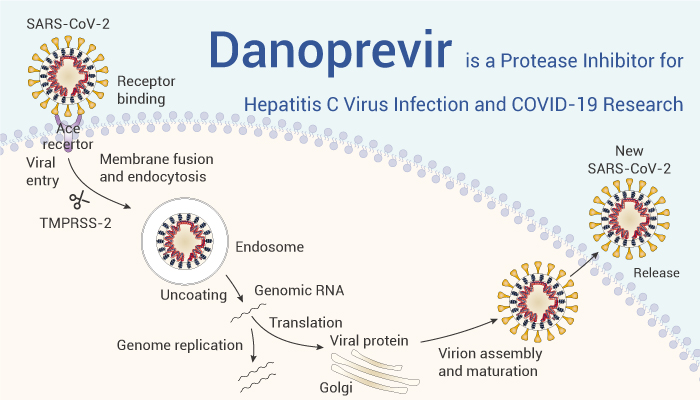Hepatitis C virus (HCV) is a common cause of chronic liver disease. HCV NS3/4A protein is a membrane targeted serine protease. Specifically, NS3-4A serine protease is a non-covalent heterodimeric complex formed by two HCV encoded proteins, the N-terminal serine protease domain of NS3, and the NS4A cofactor. Besides, it cleaves four non-structural (NS) sites to generate mature NS3, NS4A, NS4B, NS5A, and NS5B proteins. The NS3/4A protease domain is crucial for viral multi protein maturation and helps HCV evade host innate antiviral immunity. Moreover, the NS3/4A protease represents an attractive target for drug discovery. Furthermore, 3C like protease (3CLpro) is an essential enzyme for the replication of SARS-CoV-2 and other coronaviruses. In addition, 3CLpro is an established target for antiviral drugs against coronavirus. Now, we will introduce a protease inhibitor for HCV infection and COVID-19 research, Danoprevir.
Danoprevir is a Protease Inhibitor for Hepatitis C Virus Infection and COVID-19 Research.
Above all, Danoprevir (ITMN-191) is an orally active NS3/4A protease inhibitor for hepatitis C virus (HCV) with an IC50 of 0.29 nM. Nonetheless, Danoprevir is selective for NS3/4A over a panel of 53 proteases. Meanwhile, Danoprevir inhibits HCV genotypes 1a, 1b, 4, 5, and 6 (IC50s=0.2-0.4 nM) as well as 2b and 3a (IC50s=1.6, 3.5 nM). Danoprevir is also a SARS-CoV 3CLpro inhibitor with an IC50 of 0.05 μM.
Next in importance, Danoprevir shows antiviral inhibition effects against HCV genotypes 1, 4 and 6 in Huh7.5 cells transfected with chimeric recombinant virus. Particularly, Danoprevir inhibits the reference genotype 1 NS3/4A protease half-maximally. Obviously, Danoprevir eliminates a patient-derived HCV genotype 1b replicon from hepatocyte-derived Huh7 cells with an EC50 of 1.8 nM.
All in all, Danoprevir is a protease inhibitor for HCV infection and COVID-19 research.
References:
[1] Imhof I, et al. Hepatology. 2011 Apr;53(4):1090-9.
[2] Seiwert, Scott D., et al. Antimicrobial Agents and Chemotherapy (2008), 52(12), 4432-4441.
